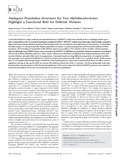Mostrar el registro sencillo del ítem
Analagous population structures for two alphabaculoviruses highlight a functional role for deletion mutants
| dc.creator | Serrano García, Amaya | es_ES |
| dc.creator | Williams, Trevor | es_ES |
| dc.creator | Simón de Goñi, Oihane | es_ES |
| dc.creator | López Ferber, Miguel | es_ES |
| dc.creator | Caballero Murillo, Primitivo | es_ES |
| dc.creator | Muñoz Labiano, Delia | es_ES |
| dc.date.accessioned | 2019-01-10T08:27:57Z | |
| dc.date.available | 2019-01-10T08:27:57Z | |
| dc.date.issued | 2012 | |
| dc.identifier.issn | 0099-2240 (Print) | |
| dc.identifier.issn | 1098-5336 (Electronic) | |
| dc.identifier.uri | https://hdl.handle.net/2454/31944 | |
| dc.description.abstract | A natural Spodoptera exigua multiple nucleopolyhedrovirus (SeMNPV) isolate from Florida shares a strikingly similar genotypic composition to that of a natural Spodoptera frugiperda MNPV (SfMNPV) isolate from Nicaragua. Both isolates comprise a high proportion of large-deletion genotypes that lack genes that are essential for viral replication or transmission. To determine the likely origins of such genotypically similar population structures, we performed genomic and functional analyses of these genotypes. The homology of nucleotides in the deleted regions was as high as 79%, similar to those of other colinear genomic regions, although some SfMNPV genes were not present in SeMNPV. In addition, no potential consensus sequences were shared between the deletion flanking sequences. These results indicate an evolutionary mechanism that independently generates and sustains deletion mutants within each virus population. Functional analyses using different proportions of complete and deletion genotypes were performed with the two viruses in mixtures of occlusion bodies (OBs) or co-occluded virions. Ratios greater than 3:1 of complete/deletion genotypes resulted in reduced pathogenicity (expressed as median lethal dose), but there were no significant changes in the speed of kill. In contrast, OB yields increased only in the 1:1 mixture. The three phenotypic traits analyzed provide a broader picture of the functional significance of the most extensively deleted SeMNPV genotype and contribute toward the elucidation of the role of such mutants in baculovirus populations. | en |
| dc.description.sponsorship | This study received financial support from the Spanish Ministry for Science and Technology (AGL2008-05456-C03-01). A.S. received a predoctoral fellowship from the Spanish Ministry of Education and Culture. | en |
| dc.format.extent | 8 p. | |
| dc.format.mimetype | application/pdf | en |
| dc.language.iso | eng | en |
| dc.publisher | American Society for Microbiology | en |
| dc.relation.ispartof | Applied and Environmental Microbiology, February 2013 Volume 79 Number 4, p. 1118–1125 | en |
| dc.rights | © 2013, American Society for Microbiology. All Rights Reserved. | en |
| dc.subject | Spodoptera exigua multiple nucleopolyhedrovirus (SeMNPV) | en |
| dc.subject | Spodoptera frugiperda MNPV (SfMNPV) | en |
| dc.subject | Occlusion bodies (OBs) | en |
| dc.title | Analagous population structures for two alphabaculoviruses highlight a functional role for deletion mutants | en |
| dc.type | info:eu-repo/semantics/article | en |
| dc.type | Artículo / Artikulua | es |
| dc.contributor.department | Producción Agraria | es_ES |
| dc.contributor.department | Nekazaritza Ekoizpena | eu |
| dc.contributor.department | IdAB. Instituto de Agrobiotecnología / Agrobioteknologiako Institutua | es |
| dc.rights.accessRights | info:eu-repo/semantics/openAccess | en |
| dc.rights.accessRights | Acceso abierto / Sarbide irekia | es |
| dc.identifier.doi | 10.1128/aem.03021-12 | |
| dc.relation.publisherversion | https://doi.org/10.1128/aem.03021-12 | |
| dc.type.version | info:eu-repo/semantics/publishedVersion | en |
| dc.type.version | Versión publicada / Argitaratu den bertsioa | es |


